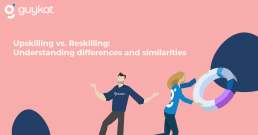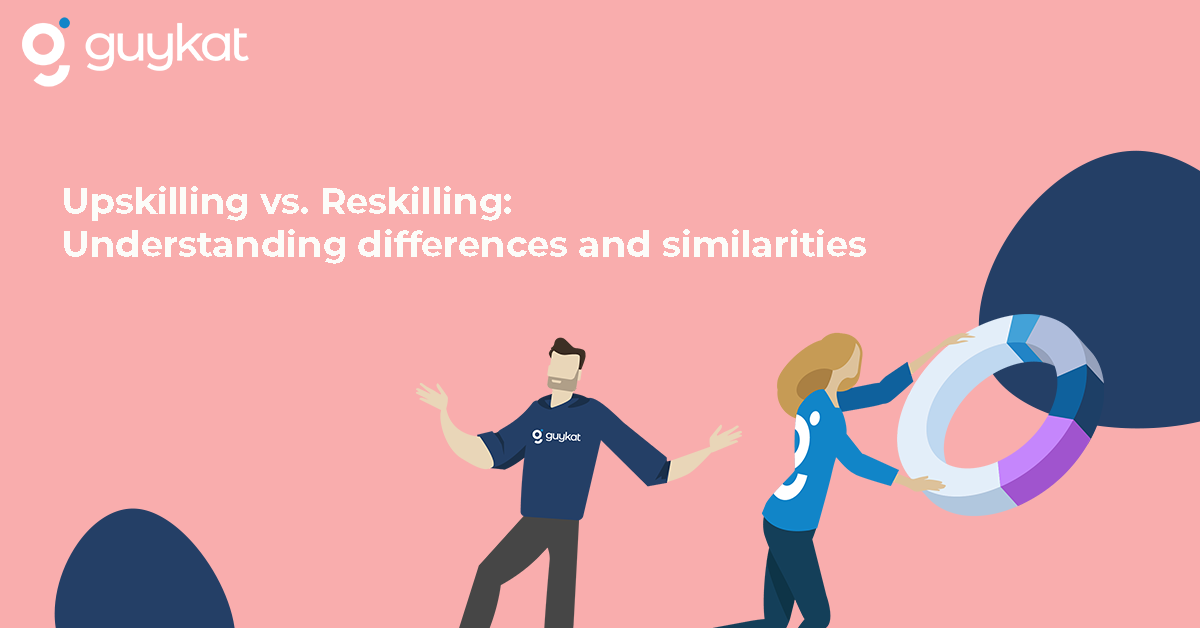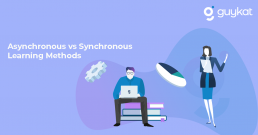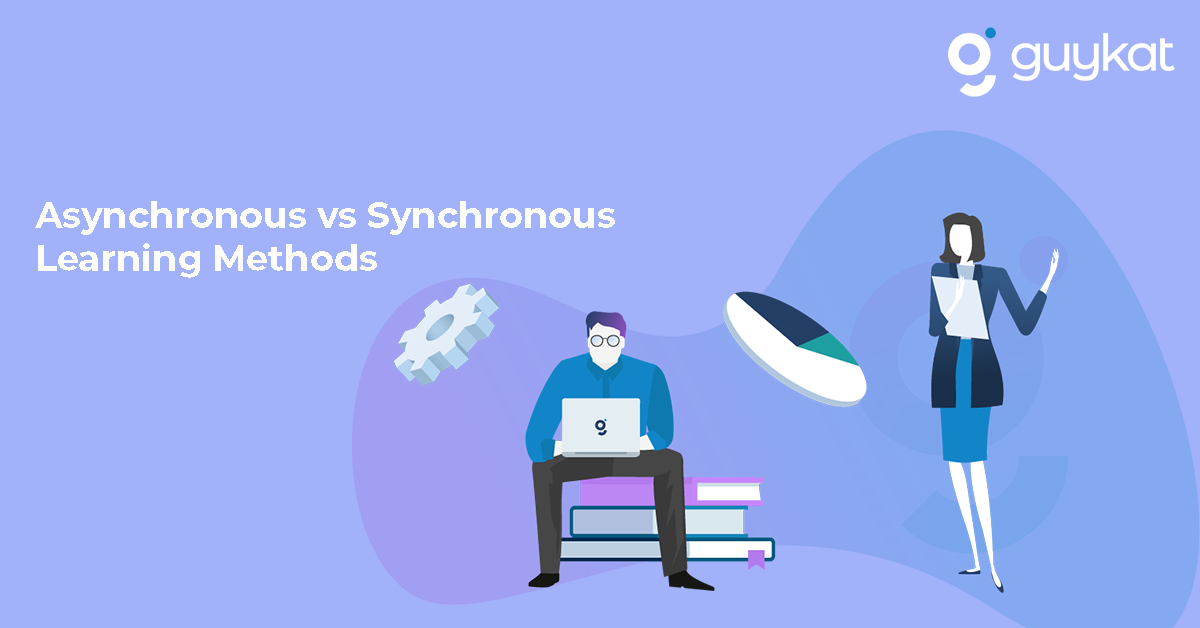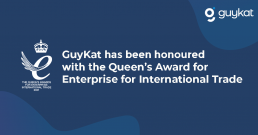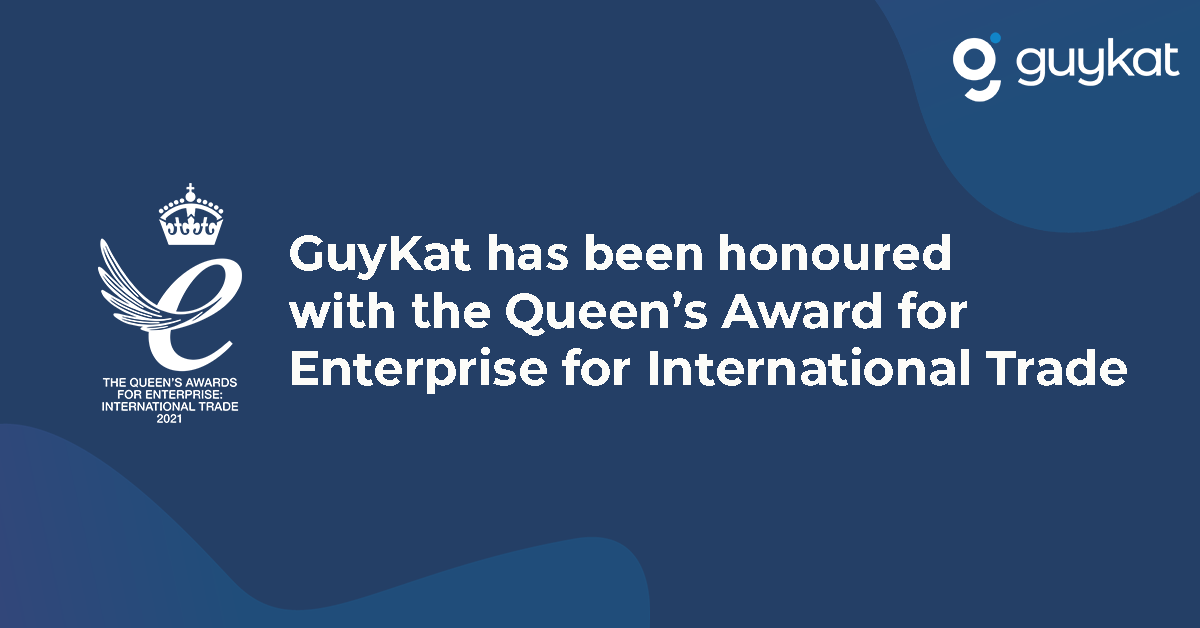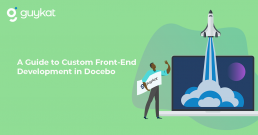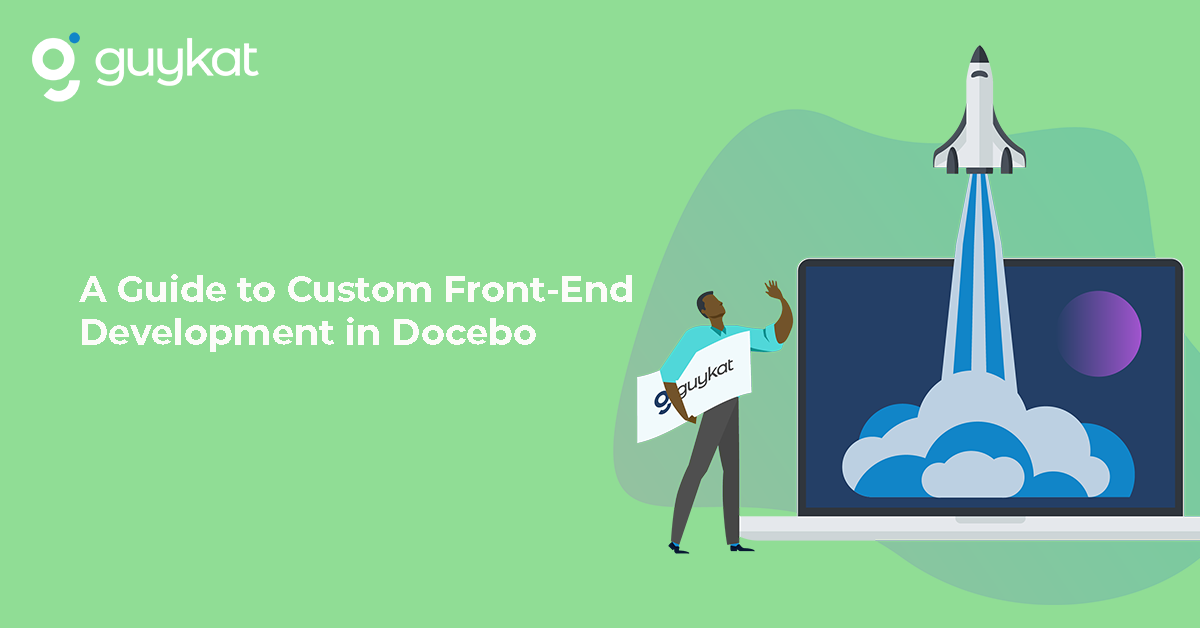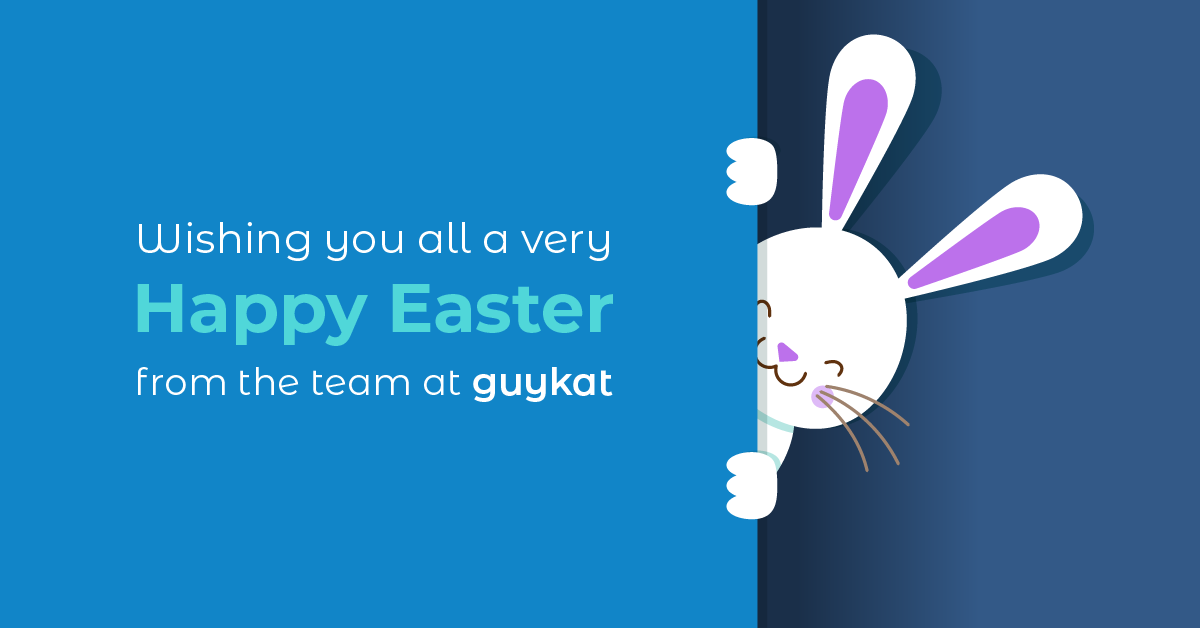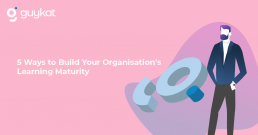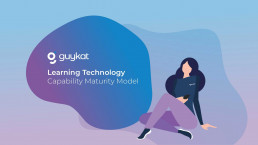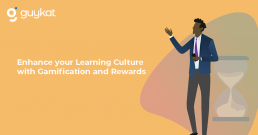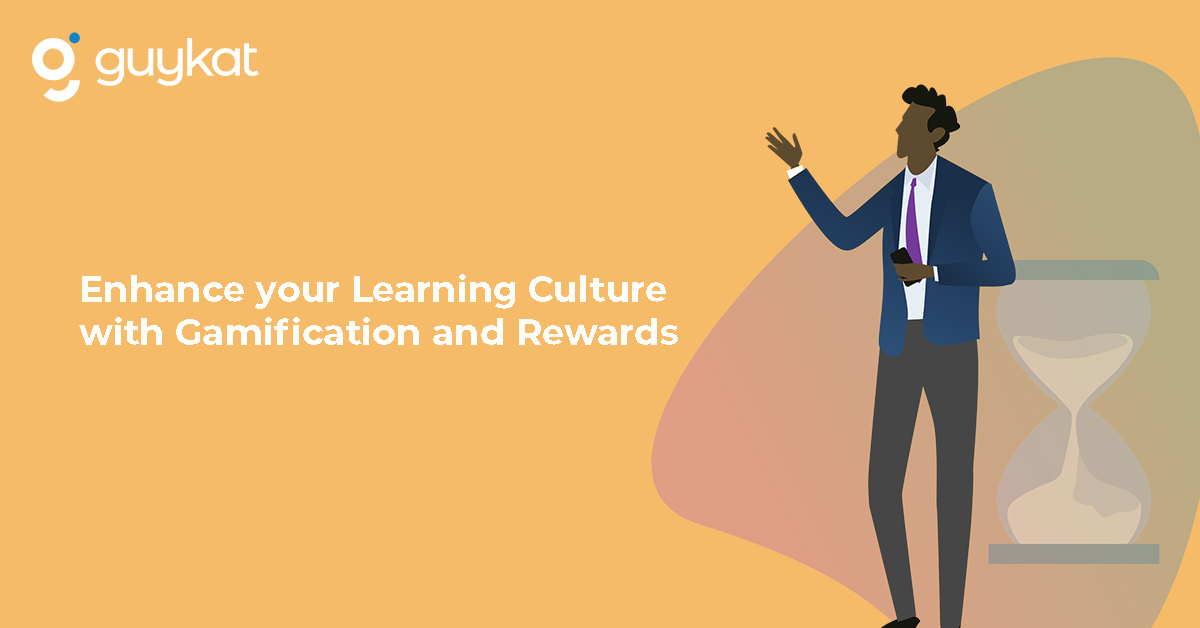Upskilling vs Reskilling: Understanding differences and similarities
Like most industries, L&D professionals have a habit of using industry jargon. Jargon can exclude bright people from being able to make valid contributions to a debate. At GuyKat, we want to be inclusive. We’re on a mission to bust the jargon. Last week we demystified the words 'asynchronous' and 'synchronous'. This week we're ready to do the same with ‘upskilling’ and ‘reskilling’...
What is upskilling?
In short, upskilling is learning fresh skills to meet the demand for new expertise. For companies, it’s a way to teach workers what they need to do their work to the best of their abilities. For employees, it’s a way to further their career path.
One example of successful upskilling is PwC, which created a ‘digital fitness’ program to teach its employees a broad range of technical skills, from programming to data analysis. To do this, the company combined several tools—apps, quizzes, podcasts, and gamification. The goal was to encourage a growth mindset and nurture competencies that will contribute back to the team.
What is reskilling?
While upskilling aims to train workers to do their current jobs better, reskilling teaches skills for employees to embark on new positions within the company. Often, the new skills are related to the ones the worker had before, but it’s not unusual for a person to dive into an entirely different niche.
One example is Scandinavian Airlines. Lockdown and travel restrictions hit the airline industry especially hard, endangering hundreds of thousands of jobs worldwide. In this context, Scandinavian Airlines positioned hundreds of workers with basic medical training in the Swedish healthcare sector by offering a three-and-a-half training course.
Both upskilling and reskilling have their advantages based on the goals of the company and the employee.
Benefits of upskilling
Attracting better talent
Top talent cares about gaining more knowledge and experience. So, companies that invest in training and upskilling will attract applicants with a growth mindset.
Improving motivation and loyalty
Employees take note when businesses invest in training, making them feel the company is committed to their growth. In turn, this boosts morale and improves performance.
Promoting stability
Ensuring that all team members have the skills to protect teams when one employee leaves, as it’ll make it easier for a new person to take over the role.
Benefits of reskilling
Reduces hiring and onboarding costs
It may take up to 50 days and over $4,000 to hire a new employee. Reskilling an employee to perform a different role within the company cuts down on these costs and it decreases the time the person will need to adapt to the new team.
Keeping talent
Providing workers with options to gain new skills and explore different paths within the company is a sure way to retain talent that would otherwise leave the company.
Retaining company knowledge
By retaining talent, companies not just ensure employees feel valued. It also guarantees the resources the company invested in nurturing a high-performing employee by teaching them that knowledge will continue to yield results.
Upskilling vs Reskilling: Which One To Choose?
Both are valuable training approaches, and choosing one over the other will depend on the goals and needs of the company and the employees.
There are several ways to teach new skills in a business setting, but three stand out:
Based on learning objectives
It refers to more structured, formal training programs like online or on-site courses or degrees. It allows employers to set up more easily quantifiable goals and clear timelines. In turn, this makes it easier for management to evaluate the results and investment of the program.
Based on learning experience
Experiential learning is another way to train employees in a more informal, practical, and hands-on approach. The goal is to create an immersive experience that will help employees to learn by doing, applying their skills in realistic scenarios.
Often, learners can use a broad range of tools—from Virtual Reality and simulations, games, projects, and peer collaboration.
Blended learning
Many skills require a combination of learning journeys, using structures programs, and practical experience to cement new skills. For example, online programs can be project-based or use games, apps, VR, or peer coaching to reinforce theory learned during class.
Why are reskilling and upskilling so important now?
In January 2020, the World Economic Forum estimated that 54% of all employees will need to be reskilled by 2022 to meet the demand for new jobs disrupted by technology.
For companies, this means massive gaps in knowledge and skills they’ll need to cover to continue operating with the same levels of productivity and efficiency.
Another significant change the pandemic has caused is the increased number of resignations across middle-career workers and management in sectors like healthcare and tech. Offering training and mobility can be a determining factor in retaining talent.
Asynchronous Learning vs Synchronous Learning
You will often hear the terms ‘synchronous’, ‘asynchronous’ and ‘blended’ learning used by L&D professionals. These terms sound complex. They’re really not. Let’s demystify them...
What is synchronous learning?
This type of learning takes place with real people in real-time (hence ‘synchronous’). Participants are required to be present – think Zoom webinars, live lectures and video conferences. It allows participants to learn from each other's expertise and perspectives while benefiting from dialogue with the instructor. With a predetermined agenda and time frame, multiple learners can interact in a set place and time.
What is asynchronous learning?
Asynchronous learning takes place on the learner's own time, allowing them to learn at their own pace. To ensure participation, there is usually a set deadline to complete any tasks or evaluations. The asynchronous experience can be facilitated through online courses, independent work, or individual projects. Learners are given more control over the extent and time they participate in a course, which makes it ideal for self-directed learners.
Pros and cons of synchronous learning
Synchronous learning has several benefits:
- Foster a sense of community and encourage peer-to-peer collaboration and personal interaction to help knowledge retention.
- Allows participants to practice new skills in real-time.
- Provides a platform for a feedback loop, from both other learners and instructors.
- Clarifying any enquiries on the spot to help learn better through supportive instruction.
However, there are also some limitations to synchronous learning, such as:
- Difficulty keeping to a shared time, due to busy schedules or other commitments, and end up missing out on important modules.
- The instructor adheres to a common pace, which may not be ideal for slower learners.
- Online sessions can run the risk of technical difficulties. (e.g. spotty internet connection, website crash)
Pros and cons of asynchronous learning
The benefits of asynchronous learning are:
- Provides a great opportunity for those who prefer to learn on their own time with little contact from the instructor.
- Ideal for busy employees who don't have time to attend live sessions.
- Allows for more time for self-reflection and going through the material multiple times.
- Accessible anywhere and anytime, in spite of different time zones or location.
There are also some disadvantages, like:
- Difficult for those who lack self-motivation.
- Lack of feedback and acknowledgement can be an issue for dependent learners.
- No real-time feedback.
Blended learning
Blended learning combines both online and offline learning deliveries, ultimately reaping the benefits of asynchronous and synchronous learning in one experience. Also known as a hybrid learning model, it allows instructors to take into account the personal learning styles and circumstances of each employee to suit their needs. Modules and courses take place both online and offline, asynchronously and synchronously, to create a myriad of instruction that is both engaging and accessible. One prime example that showcases the benefits of this combined approach is when participants are given online course supplies, allowing them to study it beforehand and discuss the material in person.
Final Thoughts
This all correlates with previous thoughts we’ve shared about when to use live instructor-led training and when to use eLearning modules. We just didn’t use fancy language!
Benefits of Starting Your Company's Learning Journey with an Agency
According to research by the Open University, 91% of UK businesses are struggling to find workers with the right skills. So, it’s a no-brainer that strengthening your current employees' skills is the best way to mitigate the lack of strong candidates.
There are many options you can take to address this, this post focuses on working with an outside agency. Agencies have access to resources that individual freelancers and small businesses don’t.
What Are The Benefits of Choosing an eLearning Agency?
- A good learning agency will have everything you need in one place - learning management systems (LMS), content creation, user experience experts, and professional services. You can access the deep expertise of the whole team across every area. By contrast, if you use contractors/freelancers, they tend to either have deep expertise in one particular niche, else be a ‘jack of all trades, master of none'.
- Agencies have ‘been there, done that’ with countless other organisations, many likely similar to you. You gain the benefit of their hard-earned experience and avoid your internal team wasting time reinventing wheels.
- The best agencies are aware of the newest and most effective eLearning and self-paced learning options. Instructional design is a professional skill. You can’t just take a subject matter expert from your organisation and expect them to play this role. Partnering them with a trained instructional designer from an agency will make a huge difference to the quality of the learning you produce.
- Working with technology can be hard. There is a learning curve to gain these skills and then an overhead in maintaining them. Having internal resource putting effort into this will be at the expense of time spent on detailed content. Content is king. Work with a good agency and you can concentrate on the content, and let the agency worry about the technology.
- A great agency will think bigger than the current project. They will support your L&D in building a strategy to use technology to create a great learning culture.
Choosing the right agency is a challenge in itself. At GuyKat we have helped organisations all over the world enjoy these benefits. We’re particularly proud of our work to partner with clients on point number 5 and help them mature their digital learning capability.
10 Ways to Make Your eLearning More Engaging
The best eLearning engages your learners and makes the complex seem simple. It connects your audience with the content and adds excitement to the learning experience. To help you achieve this, here are a handful of eLearning tips from our eLearning team.
Use creative design
It’s essential to use visuals that help to communicate the subject matter and accommodate the learning journey - overcrowded graphics and images can undermine the experience.
Having a bold colour pallet is an eLearning tip that can also make a difference. Colours can also be used to attract your learner’s attention to key information, represent your branding, or categorise the content.
People are drawn to beauty. No matter how serious the subject, the overall experience of a course can always be enhanced by good aesthetic design.
Use multimedia
If you only plan to use graphics and text, you could just share a PowerPoint. Instead, bring your eLearning content to life using multimedia, such as videos, animations or audio. By keeping it relevant and striking the right balance, you can deepen your learner’s experience and understanding of the content.
Make it interactive
Interactivity demands engagement from learners. Done well, it can make the learning experience immersive.
Different interactions can encourage your learners to discover and deepen their understanding. For example, buttons can reveal new information, while interactive scenarios can build an understanding of real-life applications.
The best interactive eLearning is similar to the old 'Choose-your-own-adventure' books*. Every learner will take their own path from start to finish, receive tailored feedback as they progress, but all finish up with the required knowledge at the end.
*Think 'Black mirror: Bandersnatch' if you're of the Netflix generation.
Test your learners
Quizzing and gamification elements can check your learner’s understanding. Providing solid feedback and self-assessment will allow your learners to be active participants. Understanding their strengths and areas for improvement will inform their development. The user interface is as important as the content in getting your learners to explore. Put thought into it.
Related content: Read more about enhancing your learning culture with gamification and rewards.
Encourage your learners to explore
Allow your learners to take the lead and navigate the content. Ensure that the structure of your content flows intuitively and allows them to explore. While you may wish to craft a specific journey, your navigation should not block your learners or hold them back.
Related content: Read more about increasing your learning engagement.
Create a narrative
The best way to engage your learners is to tell a story, rather than simply present information. To learn effectively, your learners need to personally connect with your content and be led on a journey. This is best achieved through skilled writing during the storyboarding phase of a project.
Shout about the benefit to the learner, not your 'learning objectives'
It’s much easier to motivate your learners if they believe the course will benefit them. The course designer needs to be clear on the learning objectives but these are not the same as learner benefits. Identify the learning objectives when creating the storyboard. Everything in the storyboard should help deliver these objectives. But do not list these at the start of the course. It can often turn off the learner. Instead, you should frame the 'What's in it for me?' question to motivate them.
So, don't say "During this course, you will learn the detail of the latest law on data protection, you will learn how it applies to a specific subgroup of our clients and you will learn some changes to how we enter data on the system to ensure compliance." Rather say, "There have been some recent changes in data protection law. There's a real risk that any of us could accidentally do something that could bring the whole company down. We're going to tell you what you need to know and do to make sure that person isn't you!". Now, the learner is listening.
GuyKat Tip: We encourage our clients to outline their learning objectives in their storyboards, either written explicitly in the script or considered as a thread throughout. This is because it’s vital that every element of the storyboard supports your learners in achieving their goals.
Keep it bite-sized
If appropriate, you should try to create eLearning that is bite-sized and has an overarching objective. Smaller chunks of information will be easier for your learners to digest and retain. By focusing clearly on the essential information, you’re more likely to hold your learner’s attention.
Read more: Less Is More: Organising And Reducing Content To Make It Digestible
Know your learners
Above all, your content must be tailored to your specific learners. Different audiences have different needs. For example, a younger audience may respond well to bold graphics and gamification. You need to get to know your learners and create content that is intuitive to their specific needs and is written with the right 'voice'.
Be concise
Make it easy for your learners by presenting information in a clear and simple way. Long or unrelated content can be confusing and distract from key messages.
GuyKat Tip: These tips are especially valuable if you’re making new learning content, using authoring tools such as Articulate Storyline or Adobe Captivate. If the content is vital to your business, you may want to engage professional help rather than building the content yourself.
GuyKat has been honoured with the Queen's Award for Enterprise for International Trade
BIRMINGHAM - April 29th, 2021 - GuyKat wins Queen’s Award for Enterprise for International Trade.
The outstanding export-led growth of GuyKat, a Birmingham based eLearning agency, is to be honoured with a Queen's Award for Enterprise for International Trade.
The award was formally announced in the delayed Queen’s Birthday Honours List.
The company doubled revenue between 2019-20 with 70% of sales coming from outside the UK. Full-permanent staff increased from 25 to 40, including the opening of an office in Tampa, Florida.
GuyKat’s products and services include bespoke eLearning courses, services related to the implementation and use of corporate Learning Management Systems and software development. The business helps clients teach online things that historically they would have taught in person. Overseas Sales has more than tripled in the last three years by focussing on Europe and North America. However, they have deployed learning in more than 50 countries across all continents. GuyKat takes a long-term view by engaging apprentices, graduates and first job change roles, supported with a training plan. Repeat sales rely on relationships. GuyKat have sponsored specific trade shows in Boston, Toronto and Atlanta, invested in getting their team over to the United States to meet their clients, and have acquired a sales office in Florida.
Guy McEvoy, GuyKat’s CEO, said: “I did a little jig when I found out. We realised early on that any digital company needs a global mindset. If you think of your market as ‘‘the Midlands’ or ‘The UK’, that’s fine - but thinking of ‘the World’ obviously gives so much more opportunity. Technology makes geography incidental. We saw demand in North America and have been proud to help turn that into jobs here in Birmingham. It’s great for a company like us to get this sort of recognition.”
About Queen’s Award for Enterprise
Now in its 55th year, the Queen’s Awards for Enterprise are the most prestigious business awards in the country, with winning businesses able to use the esteemed Queen’s Awards emblem for the next five years.
About GuyKat
GuyKat go beyond eLearning. Since being founded in 2009, they have been passionate about customer success. With offices based in the UK and US, GuyKat serve clients in five continents and have deployed training in over 50 countries. They are experts in UX, design and learning outcomes; they believe that fantastic UI and UX is what success is all about. GuyKat became a valued partner with Docebo in 2011, making them the first reseller to bring Docebo to the UK. Since then, their teams have developed deep expertise in Docebo.
All press enquiries:
Rugile Sikorskyte,
+44 (0)121 288 1122
GuyKat Solutions Ltd., Faraday Wharf, Holt St, Birmingham B7 4BB
A Guide to Custom Front-End Development in Docebo
It’s often assumed that good eLearning content is the key to high engagement. But, this doesn’t matter if you can’t find what you’re looking for. At GuyKat, we know that optimising the learner’s journey is just as essential. We design Docebo platforms that encourage learners to immerse themselves in your learning experience and easily discover your courses.
Here’s how we do it.
The User
To optimise the user experience (UX) and get the most out of your content, understanding your user is our first step.
We visualise where you want your learner to go and what you want them to achieve. To fully understand your user journey, we design sitemaps that display where the user can go on each page. After defining this user flow, we create a wireframe to design each page.
This process enables us, and our clients, to refine the user journey and visualise how we can achieve the learner’s goals.
The Design
We design platforms that represent your branding and bring your users back for more. A user interface (UI) should be aesthetic and authentic, facilitating your UX.
By collaborating with our clients, we refine our designs and create the best UI. We incorporate our client’s branding and build on their design visions. Next, we leverage the latest tools to provide mockups of the design that we will build.
The Build
To bring our vision to life, we build the design in your platform and implement the desired features - don’t worry, we keep it hidden from any live users.
The build is tested to ensure a smooth experience for your target learners. At this stage, we encourage our client’s feedback and a soft launch. This involves a small group of test users (not involved in the project) interacting with the platform and us gathering feedback. This gives us insight from a real learner’s perspective.
Related Content: Building a custom Docebo landing page enhances your UX.
Bespoke Software Builds
We also offer bespoke software builds for pages, to enhance the learner’s experience. We utilise Docebo’s powerful API to present data in an optimal way - this can be anything from progress bars to course completion graphs.
Learn more about our System Integration and API Development.
We work efficiently to design an intuitive and engaging platform for your users. By stretching the limits of CSS and Docebo’s API, we bring our client's visions to life and innovate their learning experiences. If you’re looking for high engagement with your eLearning, optimising your learning platform and delivering high-quality content will get you there.
Related Content: How to keep learners coming back to the system.
5 Ways to Build Your Organisation’s Learning Maturity
Last year we launched our Corporate Learning Technology CMM, showing the typical journey organisations go through with learning tech. Some get further along than others. Those that ‘go all the way’ and make best use out of their technology, truly put Learning at the centre of their culture. If you missed it, then you can find out more about our maturity model here https://www.guykat.com/en_us/corporate-learning-technology-model/.
We’ve had a couple of questions about things organisations might do to speed through this journey. Though this isn't a definitive list, here are five things you should think about:
Encourage Participation
The more engaged your learners are, the quicker their development. You need to empower your learners to drive their own growth and motivate them to discover your content.
For example, you could implement:
- Gamification - In Docebo, you can include gaming elements (e.g., competitive point scoring) to engage your learners and encourage them to explore your content.
- Rewards - You could reward your learners for achieving milestones, acknowledging their progress and efforts. Championing their achievements will incentivise their success.
- Self-enrolment - Your learners could have the freedom to enrol on relevant courses that interest them. Give them autonomy and trust them to take initiative in shaping their learning.
Offer Variety
Create an exciting learning environment by offering a variety of delivery methods and experiences. This will broaden your learner’s development prospects and enhance the effectiveness of your learning journeys. If you only offer click-and-read eLearning, your learners will lose interest. Mix it up!
For example, you could offer:
- Blended learning - You could combine a mix of learning approaches to add depth to your learning experience. For example, your online training could complement your instructor-led training (classroom training). This hybrid approach could improve efficiency and give you the best of both worlds.
- Multimedia - Include a variety of relevant media in your content, such as different videos, images, text, interactivity, or animation. Using the right amount of media is more likely to retain your learners’ attention.
- Bespoke eLearning - One of the best ways to engage your learners is by catering to their needs, beyond compliance training. You could partner with a content provider to design bespoke eLearning that represents your branding and subject matter. Increase the value of your content and move away from the basics of off-the-shelf learning.
Tailor the Experience
These days, learners want accessible and convenient digital content that is intuitive to their needs. You should tailor the structure of your content and Learning Platform to suit your learners’ different goals.
For example, you could:
- Create content that is tailored for different paths of career development.
- Utilise learning plans in Docebo to provide relevant development structure and guide your learner throughout their journey.
- Ensure that your content is adaptable and responsive, particularly to different technology devices (like mobile).
Build a Collaborative Culture
Let your learning strategy evolve with your learners. Place learning at the heart of your company by creating a social learning environment. Empower your learners to collaborate with each other, share their knowledge, and contribute to your Learning Platform. This way, they are more likely to feel valued and champion your learning culture.
Benchmark your Progress
Keep track of your learners’ data to continually improve your Learning Platform experience. Decide on your KPIs and other data that you want to capture and benchmark them frequently.
For example, to measure the effectiveness of your Learning Platform you could report:
- The number of self-enrolled learners on your courses.
- Course completion rates.
- Course test results.
GuyKat launches the Corporate Learning Technology Capability Maturity Model
TAMPA - March 24th, 2021 - GuyKat Inc. (GuyKat) launches the Learning Technology Capability Maturity Model (CMM).
GuyKat has developed a Corporate Learning Technology Capability Maturity Model. This gives you a benchmark based on your Learning Technology capability. It also helps you to create a transformation plan to reach your ambition.
The model was inspired by the use of CMMs in other industries, such as Project Management. The authors applied their experience, Research & Development, and engagement with L&D professionals to create a similar model to apply to corporate Learning Technology.
GuyKat is launching the Learning Technology Capability Maturity Model and it can be found on www.guykat.com/learning-technology-capability-maturity-model.
Learning Technology CMM:
- A capability maturity scale from 0 to 5.
- An overview of the Use of Technology, Technology in Place, and the Feel for each level.
- Organisations are encouraged to contact GuyKat to help them with their transformation plan.
The audience for this model has been categorised into four groups:
Learning and Development Professionals
Do you work in L&D but don’t know the right level of investment in technology to support your learning goals?
Functional Leaders
Do you have accountability for ensuring best practice, or creating an Academy or Centre of Excellence for a function in your business (e.g. sales or finance)?
Partner Enablement Professionals
Are you looking to share knowledge externally with your partners, distributors and suppliers?
Learning Technology Professionals
Are you involved in the sale or implementation of Learning Technology?
“The model is a simple tool. It helps when thinking about goals for any Learning Technology investment. It’s been put together based on our years of experience in facilitating this type of conversation between the people who want to use Learning Tech and the people in their organisation who pay for it.”, said Guy McEvoy, CEO and founder of GuyKat.
About GuyKat
GuyKat goes beyond eLearning. Since being founded in 2009, they have been passionate about customer success. With offices based in the UK and US, GuyKat serves clients in five continents and have deployed training in over 50 countries. They are experts in UX, design and learning outcomes; they believe that fantastic UI and UX is what success is all about. GuyKat became a valued partner with Docebo in 2011, making them the first reseller to bring Docebo to the UK. Since then, their teams have developed deep expertise in Docebo.
Enhance your Learning Culture with Gamification and Rewards
What drives you to learn? Usually, it’s the reward that comes with completing the learning. For example, if you have a new IT system, it’s the need to gain the ability to use it that drives your learning. Take that away and there’s no benefit of gaining that knowledge.
The same drivers apply to organisational learning. Knowing this, we can use gamification and rewards to motivate engagement with learning. Docebo has specific features to help you take advantage of this.
We spoke with GuyKat’s LMS Analyst Jenny Jackson, who shared some thoughts on Gamification and Rewards.
What is Docebo Gamification and Rewards?
You can configure your system so that users can earn both virtual and physical rewards. For instance, your users can earn virtual badges based on the criteria that you define. The more they engage with the system in the way you want them to, the more badges are added to their profile. This can be taken a step further by adding a coin value to each badge. They can then use their accumulated coins to buy physical rewards from your rewards shop. Users can earn badges for completing courses, scoring highly in tests, or using Learn, Coach & Share. For an extra competitive boost, users can be part of the leaderboard or earn bonus badges (and points!) for coming top in contests.
What activities should be rewarded?
Reward the amount of effort for each activity. Create a plan of what activities are worth higher points.
For example:
- Creating and having approved a learning resource in Learn, Coach & Share should award more points than the activity of commenting or asking a question.
Reward with higher points if training is undertaken at a scheduled time.
For example:
- If training is scheduled at a specific time that the user would have to use their free time to attend, that should award significantly more points or higher kudos than training that is ‘on demand’.
What rewards are available?
As a super admin on the Docebo platform, you have access to a Reward shop tool. There are two ways of using the Reward shop:
- Extrinsic: Rewarding learners with tangible goods, so long as you can fulfil them. It could be, for example, a coffee voucher, a T-Shirt, a product or a discount at one of your company’s affiliated stores.
- Intrinsic: If you have a low budget, you might want to consider having a ‘kudos’ based rewards strategy, whereby you make full use of the leaderboards or company communications to shout about your really engaged, high-scoring users.
What are the Leaderboards and Contests?
Leaderboards in Docebo show users' points accumulation against one another.
Contests award a points/badge bonus for the highest scorer of points:
- For the user who completes the most courses.
- For the user who gets the most 'helpful' marked comments in Learn, Coach & Share course forums.
- For the highest scorer in a quiz, within a set timeframe.
It’s possible to set up leaderboards by branches or groups - in this way you could create competition within teams or divisions, or even between parts of a country!
GuyKat tip: We recommend finding a small team to test out your leaderboards and competitions first.
Final thoughts
Before enabling all these features, think about your organisation’s culture. Some workforces respond well to public competitive elements like leaderboards, some don't. Equally, some professionals may find virtual badges gimmicky. You know your organisation best. Tailor the features you use accordingly.

